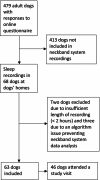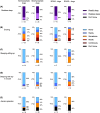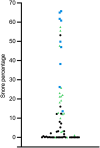Evaluation of risk factors for sleep-disordered breathing in dogs
- PMID: 38358051
- PMCID: PMC10937515
- DOI: 10.1111/jvim.17019
Evaluation of risk factors for sleep-disordered breathing in dogs
Abstract
Background: Brachycephalic dogs display sleep-disordered breathing (SDB). The risk factors for SDB remain unknown.
Objectives: To identify risk factors for SDB. We hypothesized that brachycephaly, increasing severity of brachycephalic obstructive airway syndrome (BOAS), excess weight, and aging predispose to SDB.
Animals: Sixty-three privately owned pet dogs were prospectively recruited: 28 brachycephalic and 35 normocephalic (mesaticephalic or dolicocephalic) dogs.
Methods: Prospective observational cross-sectional study with convenience sampling. Recording with the neckband was done over 1 night at each dog's home. The primary outcome measure was the obstructive respiratory event index (OREI). Body condition score (BCS) was assessed, and BOAS severity was graded for brachycephalic dogs.
Results: Brachycephaly was a significant risk factor for high OREI value (ratio of the geometric means 5.6, 95% confidence interval [CI] 3.2-9.9; P < .001) but aging was not (1.1, 95% CI 1.0-1.2; P = .2). Excess weight, defined as a BCS of over 5/9, (3.5, 95% CI 1.8-6.7; P < .001) was a significant risk factor. In brachycephalic dogs, BOAS-positive class (moderate or severe BOAS signs) was a significant risk factor (2.5, 95% CI 1.1-5.6; P = .03).
Conclusions and clinical importance: Brachycephaly decreases welfare in a multitude of ways, including disrupting sleep. Brachycephaly, increasing severity of BOAS and excess weight are risk factors for obstructive SDB.
Keywords: brachycephalic obstructive airway syndrome; obstructive respiratory event index; obstructive sleep apnea; sleep-disordered breathing.
© 2024 The Authors. Journal of Veterinary Internal Medicine published by Wiley Periodicals LLC on behalf of American College of Veterinary Internal Medicine.
Conflict of interest statement
Sari‐Leena Himanen has been a medical advisor for Nukute Ltd. and does not have a current financial relationship. No other authors declare a conflict of interest.
Figures





Similar articles
-
Description of a novel method for detection of sleep-disordered breathing in brachycephalic dogs.J Vet Intern Med. 2023 Jul-Aug;37(4):1475-1481. doi: 10.1111/jvim.16783. Epub 2023 May 26. J Vet Intern Med. 2023. PMID: 37232547 Free PMC article.
-
Echocardiographic parameters in French Bulldogs, Pugs and Boston Terriers with brachycephalic obstructive airways syndrome.BMC Vet Res. 2023 Feb 15;19(1):49. doi: 10.1186/s12917-023-03600-9. BMC Vet Res. 2023. PMID: 36793024 Free PMC article.
-
Whole-Body Barometric Plethysmography Characterizes Upper Airway Obstruction in 3 Brachycephalic Breeds of Dogs.J Vet Intern Med. 2016 May;30(3):853-65. doi: 10.1111/jvim.13933. Epub 2016 May 9. J Vet Intern Med. 2016. PMID: 27159898 Free PMC article.
-
Updates in Upper Respiratory Surgery.Vet Clin North Am Small Anim Pract. 2022 Mar;52(2):339-368. doi: 10.1016/j.cvsm.2021.12.002. Epub 2022 Jan 24. Vet Clin North Am Small Anim Pract. 2022. PMID: 35082092 Review.
-
Brachycephalic obstructive airway syndrome: much more than a surgical problem.Vet Q. 2022 Dec;42(1):213-223. doi: 10.1080/01652176.2022.2145621. Vet Q. 2022. PMID: 36342210 Free PMC article. Review.
Cited by
-
An Exploratory Study on the Relationship Between Idiopathic Epilepsy and Sleep in Dogs.J Vet Intern Med. 2025 Mar-Apr;39(2):e70026. doi: 10.1111/jvim.70026. J Vet Intern Med. 2025. PMID: 40088206 Free PMC article.
-
Harnessing Simple Animal Models to Decode Sleep Mysteries.Mol Biotechnol. 2024 Nov 23. doi: 10.1007/s12033-024-01318-z. Online ahead of print. Mol Biotechnol. 2024. PMID: 39579174 Review.
References
-
- Hendricks JC, Kline LR, Kovalski RJ, O'Brien JA, Morrison AR, Pack AI. The English Bulldog: a natural model of sleep‐disordered breathing. J Appl Physiol. 1987;63:1344‐1350. - PubMed
-
- Hendricks JC, Kovalski RJ, Kline LR. Phasic respiratory muscle patterns and sleep‐disordered breathing during rapid eye movement sleep in the English Bulldog. Am Rev Respir Dis. 1991;144:1112‐1120. - PubMed
-
- Hinchliffe TA, Liu NC, Ladlow J. Sleep‐disordered breathing in the Cavalier King Charles spaniel: a case series. Vet Surg. 2019;48:497‐504. - PubMed
-
- Medicine AAS. International Classification of Sleep Disorders. 3rd ed. Darien, Illinois, USA: American Academy of Sleep Medicine; 2014.
Publication types
MeSH terms
Grants and funding
LinkOut - more resources
Full Text Sources
Medical

